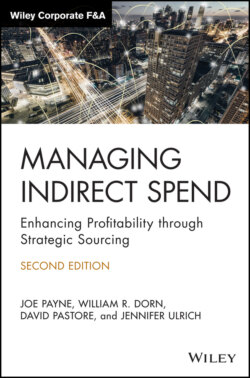Читать книгу Managing Indirect Spend - Joseph Payne, Joe Payne - Страница 49
Specifications
ОглавлениеSpecifications, which define specific criteria regarding attributes, quality, or performance, are typically included in a purchasing agreement for products. Specifications are often defined in raw materials agreements but can be overlooked when dealing with indirect spend categories. However, understanding specifications for indirect spend categories can be just as important. Let's use office supplies as an example. In your organization, you might have some employees who use standard blue, ballpoint pens and others who require felt‐tipped pens. Some pens may have a special type of grip. And the executive or Sales team might have specially made pens with a logo or other features. In this scenario, asking a supplier to price out pens results in receiving a very diverse set of quotes.
In areas like office supplies, you might find it nearly impossible to get a good idea of specifications for every potential purchase. You probably buy many different types of pens, staplers, and paper clips, among other items. How can you be expected to sit down with everyone within your organization who purchases office supplies to understand what it is they purchase? That process is time consuming at best and, in many cases, just unfeasible.
Rather than interviewing each end user about the specifications of hundreds of different products, you can collect this information from the current supplier by requesting the manufacturer name and part number to be provided in a line‐item usage report. If the goods are purchased through a distribution model (in which the manufacturer sells the goods to the distributor and the distributor sells the goods to you), the manufacturer part number provides competing suppliers with a good indication of the exact product being purchased and ensures an apples‐to‐apples comparison.
While requesting the manufacturer part number works well in a distributor model (or a model in which the products purchased are standardized), it will not help if the product you are purchasing is customized (or semi‐customized) for your organization.
Examples of customized products might include corrugated boxes or printed marketing materials. In these cases, asking for the manufacturer part number will not give you the information you need to understand what is being purchased, nor will it provide alternate suppliers with a clear understanding of your requirements. If you are not already familiar with the products being purchased, you can take several steps to quickly get up to speed on important specifications.
First, during the supplier interview, ask suppliers to detail the factors that affect the cost of the product—specifically those related to the construction of the product. For a corrugated box, ask them to provide specifications, such as box dimensions, box strength, color, and other relevant factors.
Second, take a look at similar products being purchased online. What do suppliers indicate as important specifications when selling their products? In some cases, suppliers might even put a quote form on their website. What information are they asking for in order to provide quotes?
Lastly, ask the supplier for a specifications sheet, which can give you a precise list of all the important specifications tied to a particular product. A word of caution—if you are purchasing a product that is proprietary to your current supplier (this is the only supplier in the market who sells it), the supplier may ask you to sign a nondisclosure agreement before providing you with specifications. In this case, you are obligated not to share the specifications with others outside your organization, including competing suppliers.
